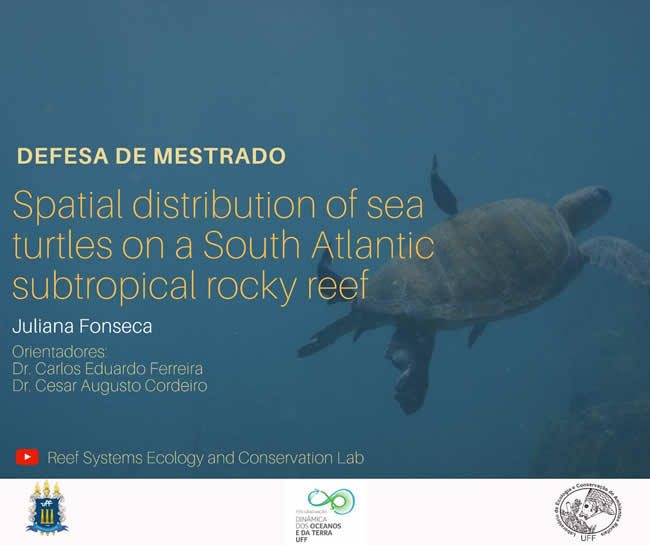|
Spatial distribution of sea turtles on a South Atlantic subtropical rocky reef No dia 18 de março de 2020, tivemos a defesa de mestrado intitulada “Spatial distribution of sea turtles on a South
Atlantic subtropical rocky reef” junto ao Programa de Pós Graduação Dinâmica dos Oceanos e da Terra. A defesa
ocorreu em meio ao cenário de crise global e pandemia do Coronavírus. Apesar do cenário de reinvenção das
comunicações interpessoais, deve-se salientar a importância da comunicação científica e devolutiva à sociedade,
assim a transmissão e disponibilização pública da apresentação já eram a realidade dessa defesa. Além de ter
sido transmitida ao vivo pelo Instagram do Projeto Mar de Tartaruga, a apresentação está disponível no canal do
LECAR.
Neste trabalho, produzimos estimativas de abundância e investigamos padrões de distribuições de
tartarugas marinhas em locais direta (oeste) e indiretamente (leste) influenciados por eventos de ressurgência em
um recife rochoso subtropical brasileiro (23°S, 42°W). A fim de garantir que essas espécies móveis fossem
adequadamente amostradas, foram realizados transectos subaquáticos cronometrados. Observamos apenas
duas espécies de tartarugas, sendo que a tartaruga-verde (Chelonia mydas) foi quase 10 vezes mais abundante
do que a tartaruga-de-pente (Eretmochelys imbricata), o que já era esperado dada a preferência geral de C. mydas
em se alimentar de algas e dos extensos bancos de macroalgas na região. A distribuição das tartarugas-de-pente
espelha padrões latitudinais observados ao longo da costa brasileira, onde essa espécie tropical é dominante
nos recifes do nordeste (semelhante aqui à localização leste). Embora amplamente distribuída, a abundância de
tartarugas-verdes variou significativamente com as características de profundidade e localização em uma escala
de poucos quilômetros. As tartarugas-verdes foram mais abundantes na localização mais fria e exposta (oeste) e
nos primeiros metros da coluna d’água. No geral, a abundância de tartaruga-de-pente e tartaruga-verde foi
relativamente maior em comparação a outros recifes subtropicais, o que confirma a importância regional de Arraial
do Cabo. Este estudo destacou que métodos simples podem produzir estimativas confiáveis da abundância e
densidade relativa de tartarugas marinhas em áreas rasas de forrageamento, quando as limitações são
consideradas. O entendimento da abundância e distribuição nos recifes brasileiros contribuirá para esforços
nacionais de planejamento de conservação, como estratégias de manejo e a priorização espacial de áreas críticas
de forrageamento.

English version
On March 18, 2020, we had a master’s defense entitled “Spatial distribution of sea turtles on a South Atlantic
subtropical rocky reef” developed within the Programa de Pós Graduação Dinâmicas dos Oceanos e da Terra
(UFF). The defense took place in the context of the global crisis and COVID-19 pandemic. Despite the current
scenario of interpersonal networks redefining, it should be emphasized the importance of scientific communication
and feedback to society, so the transmission and public availability of the presentation were already the reality of
this defense. Besides being broadcasted live on the Instagram of Projeto Mar de Tartaruga, the presentation is
available on the LECAR’s channel.
In this study, we produced estimates of sea turtle density and investigated their distribution patterns in locations
directly (western) and indirectly (eastern) influenced by upwelling events on a Brazilian subtropical rocky reef (23°S,
42°W). To ensure that these mobile and sparse distributed species were adequately surveyed, underwater timed
strip transects were conducted. We only observed two species with green turtle (Chelonia mydas) being almost 10
times more abundant than hawksbill turtle (Eretmochelys imbricata), driven by the presence of large macroalgae
beds which represent the primary food for C. mydas. The distribution of hawksbill turtles mirrored large-scale
latitudinal patterns observed along the entire Brazilian coast, where this tropical species is dominant on
northeastern reefs (similar to the eastern location). Although widely distributed, the density of green turtle varied
significantly with depth and local features on a scale of a few kilometres. Green turtles were more abundant in the
colder-exposed location (western) and in the first few meters of the water column. Overall, the density of hawksbill
and green turtles were higher compared to other subtropical coastal sites, which confirms the regional importance
of Arraial do Cabo. This study highlighted that simple methods and basic data analysis can produce reliable
estimates of relative abundance and density of sea turtles in shallow foraging areas when limitations are
considered. Moreover, understanding the distribution patterns of sea turtles along Brazilian reefs will contribute to
national conservation efforts, such as management strategies and the spatial prioritization of critical foraging areas. |










